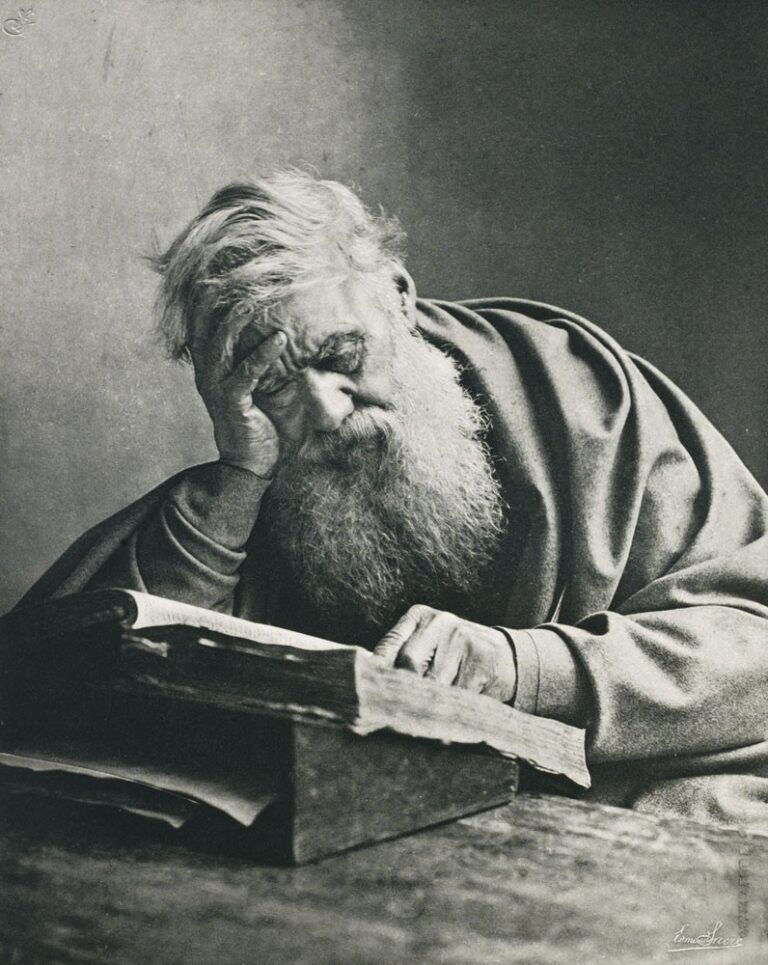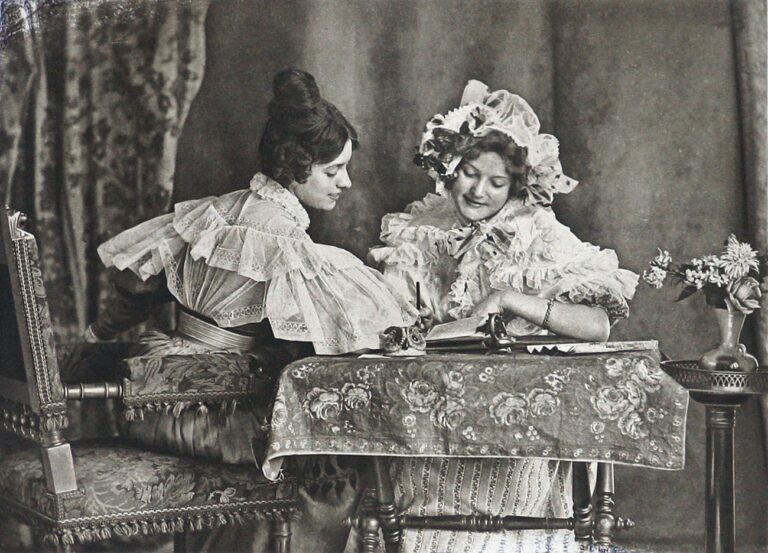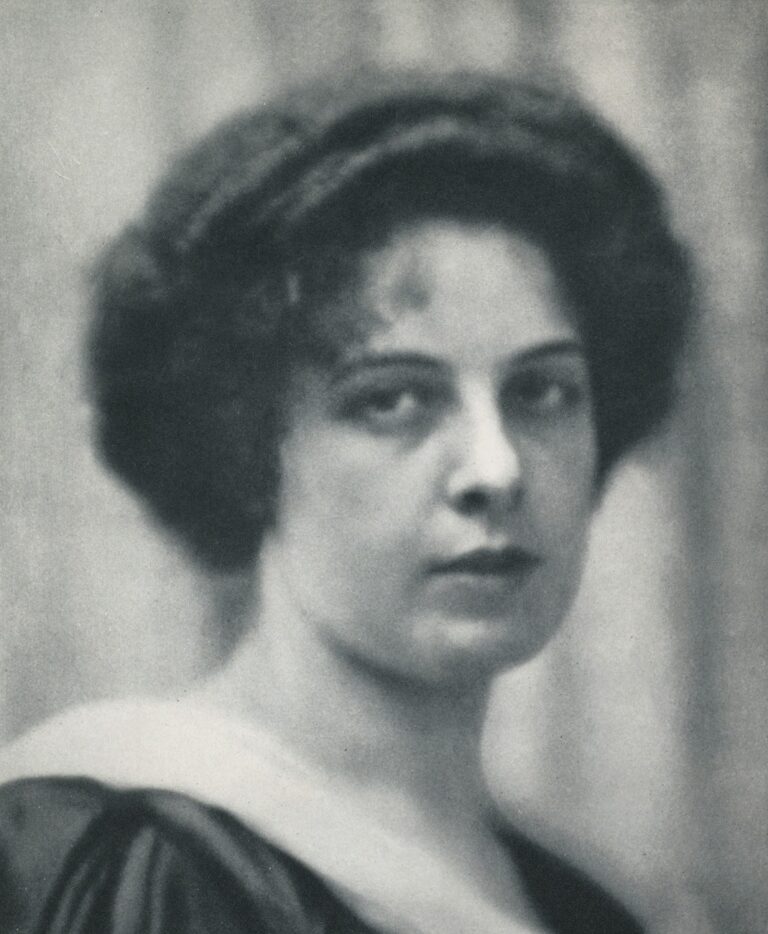
Contentment
This rustic genre photograph by the amateur photographer Winfield Scott Clow, 1841-1915, shows a fine command of figural proportion, with the four subjects balanced within the frame by two separate doorways. The railing at far right and bench of potted flowers at left leads the viewer into the frame, with hanging dustpan at right and bird cage at upper left (barely visible) giving additional symmetry to the overall composition.
timeline
1889: Clow elected a member of The Photographic Society of Philadelphia.
1893: Living in Philadelphia, Clow awarded a silver medal in late April at the Sixth Annual United Societies’ Exhibition at Philadelphia, comprised of the Photographic Society of Philadelphia; The Camera Club, of Boston; and the Society of Amateur Photographers of New York, held the galleries of the Pennsylvania Academy of the Fine Arts in Philadelphia.
1898: Clow listed as being a member of the Pittsburgh Amateur Photographers’ Society (Photographic Times)
1899: Living in Peru, Ill, Clow exhibits at the Second Philadelphia Photographic Salon. His prints listed in the catalogue were:
77. Where Troubles End.
78. Who Can Tell What a Baby Thinks?
1915: obituary: Winfield S. Clow:
Winfield Scott Clow, secretary of the Illinois Zinc Company, of Peru, Ill, and a former resident of Philadelphia, died at the home of his daughter, Mrs. James B. Stevenson, in Pettsburgh, according to information received in this city today. Mr. Clow, who was 74 years old, fought with the Army of the Potomac, under General McClesllan, during the Civil War. He was auditor for a Philadelphia newspaper at one time, and later was connected with the Pittsburgh Forge and Iron Company. (source: Philadelphia Evening Public Ledger – April 23, 1915 )
Contentment was published as a full-page halftone in the July, 1896 issue of The American Amateur Photographer; part of a lengthy overview of Clow as a leading amateur. From the article, we can surmise he took up amateur photography around 1888. A lengthy description of Contentment is included with the article, which runs from pp. 290-297 and includes several other printed examples of his work:
Our Leading Amateurs.
W.S. Clow
THE desire to employ every possible lever in the carrying out of the main object of the American Amateur Photographer—the elevation of photography as an art—induces us, in the hope of thereby promoting a helpful spirit of emulation, to publish a series of articles giving a brief account of the characteristics, methods, and productions of our leading amateurs, and we select for the first W.S. Clow, of Pittsburg, Pa., not because of any supposed pre-eminence, but simply because we happen at the moment to have before us a number of his beautiful pictures. W. S. Clow is a busy business man, whose lines have been cast in one of the busiest manufacturing centers of the country, and who finds in photography a pleasant recreation and delightful change of occupation during vacations, to which times his picture making is almost altogether confined.
Genre, as is evident from his work, is his favorite department, and of that he prefers scenes from everyday life, looking for the natural rather than the strained and artificial ; but aiming always at correct composition and effective lighting, and both according to the good old canons which he has studied to advantage.
But although genre is his favorite, he has an eye for the beautiful and picturesque in landscape, and has in that department produced some fine pictures, as will be seen from what we have already reproduced, and what we have yet to engrave. Although, so far as we have seen, sticking to what he calls “the old style,” he has nothing to say against impressionism ; thinks it indeed beautiful in the hands of Stieglitz, Clements, and those of that class; but that it is so intimately connected with the individuality of the man, only a true artist should try it. We quite agree with him, and therefore hope to see some of it in his pictures yet.
An experience of eight years has taught him that single methods are best, and he finds his subjects in the highways and byways—especially the byways, and around the homes of the people, the more unsophisticated and the farther removed from the beaten path the better. He finds considerable benefit from a plan that we have long recommended, that of first choosing a title for the picture, and then working up to it. There is more in a name, when it happens to be in perfect harmony, not only with the subject, but with all the details thereof, than some are ready to believe, and it must be evident that the many little details are more easily and more effectively adjusted to a title than a title, found for them after they are all arranged.
Mr. Clow has not yet ventured to compete with either our British or Continental brethren on their own ground, but we have before us several pictures that would command attention in any of their exhibitions. His work, however, is well known, and has been awarded both medals and diplomas in many of the competitions on this side, and was an attractive element in the Timmins collection, which includes some of the best work that the world has yet produced.
The following are a few examples, selected at random, and but briefly noticed, as our readers will learn more of the style of Mr. Clow’s work from our illustrations than from any description.
“Contentment” is a beautiful picture, complete in every part, and as a composition a triumph in the balancing and harmonizing of straight lines and the perfection of contrast. A “board” house that has seen better days; the grandmother on the ”stoop” knitting a stocking, the grandfather just within the doorway, an open book on his knee, making plainer to her the passage just read. A married daughter with, presumedly, a baby in her lap, sits in the shade inside, the dark figure against the brilliant light of an opposite door, and a boy leaning listlessly on the “stoop ” rail, while a thermometer, bird cage, and row of flowers in pots give an indication of a degree of culture a little above the common. We have often spoken of the importance of little things, and in this picture we have an illustration of the fact. In nine cases out of ten. the old man would have been represented in the act of reading; Mr. Clow and those who have learned to see as he does, can see in the fact that he is explaining to his aged partner an obscure passage, or commenting on one that is mutually interesting, the delicate touch that gives an additional charm to the whole.
Simpler in composition, but hardly less interesting, is “Solid Comfort.” The motif is similar to that of ” Contentment,” but with only two figures—a middle-aged husband and wife, and the home has not attained to the dignity of a “stoop,” simply a boardwalk along its side. Autumn and forethought are indicated by bunches of herbs hanging on the wall to dry, and probably about the average lack of knowledge too, else they would have been dried in the dark. Seated on a weather-worn bench close to the wall are husband and wife ; the latter with the ever present knitting, but the wires have ceased to click, showing how intently she listens to the opinions of the former on what he has just been reading in the Household Journal. The importance of the subject, and the emphasis with which it is discussed, is indicated by the removal of the spectacles and the action of the hand that holds them. It is a fine picture, and true representation of a variety of life common in all countries, and which includes a degree of happy contentment often vainly sought for in higher walks of life.
“Listen to My Tale of Woe.” At a recent exhibition of the Pittsburg Society, where visitors cast votes in favor of the most popular picture, this got the greatest number, and a bromide enlargement was made from the negatives to adorn the rooms of the society. It deserved the honor, and is another proof of the beauty of simplicity. A boy sits on a box playing a harmonica or mouth organ, and in front and close to him stands a huge curly-haired dog, head erect, and howling out its disapprobation of the music. Composition and light and shade are admirable, and the surroundings are so subdued as to lead the eye to the objective point and keep it there.
“Apple Butter—the Start,” is as realistic as it is satisfactory. Two women and a girl, well grouped and surrounded by tubs and pails of apples, are busy peeling and preparing them for the kettle. Squatted down a little to the right, in a corner where he can get a comfortable lean, is a young man just returned from fixing the fences, as is indicated by the large mallet on which his arms rest. It is quite evident, however, that the position has been chosen mainly that he might be able to see and be seen by the girl, and from the smile on her face it is easy to read the old, old story, the story, that has been, is now, and ever shall be.
“Wayside Gossip.” Those who speak contemptuously of the canons of art should study and analyze this fine picture, and they will be forced to the conclusion that there is more in them than they had supposed. The “born artist,” he who instinctively, as it were, makes a fine picture without knowing anything about, or thinking of the laws that lead to true pictorial effect, obeys them without knowing it; but we have it on Mr. Clow’s own authority that he has studied them, and with what result this picture shows. Principal objects, balance, contrast, harmony, atmosphere, all are here, uniting in a complete whole that leaves nothing to be desired. A winding road starts from the foreground, to which interest is given by two plank bridges, and in the middle distance a rider in a buggy coming meets another on horseback going, and they stop to have a chat. From both right and left of the foreground the eye is led direct to the objective point, and may wander along the winding way till it is lost in the distant atmosphere, kept in its course by the masses of foliage on the right, beautifully balanced and supported by the less obtrusive tree on the left. It is indeed a very fine example of landscape work.
The versatility of the artist is shown in “The Glen Scalp Level,” a picture in a totally different style, but in every respect as fine. A dense mass of trees through an opening in which flows towards the point of view a stream suggestive of trout Rising in the misty distance, it rapidly widens as it approaches the foreground, where it flows over successive ledges with a motion so gentle as to suggest repose. The rocky foreground on the left leads the eye to the massed trees on the right and left, which, standing as they do, at contrasting angles, suggests the idea of a protecting care over the stream. In this picture our readers will see another perfect landscape.
In “Paint Creek” our amateur deals with similar material, trees, rocks and water, but the suggestion is of action rather than of repose. The middle distance is massive foliage, divided by a cleft of light, hazy in the distance, but towards the middle showing a rapid stream terminating in a fall over a rocky ledge into a dark, deep pool, across the surface of which is a brilliant broad band of reflected light. This, too, is a very beautiful picture, and an instructive example of the value of the vertical form, rather thin that of the horizontal, for subjects of this class.
Lack of space will not permit of our noticing the other pictures kindly sent us by Mr. Clow, some of which are: ”82 in the Sun,” “Five Minutes for Refreshment,” “Industry,” “Memorials of the Past,” “Mountain Maid,” “Washing Day,” “The First Lesson in Art,” etc., some of them quite equal to any of those noticed, and all of a high degree of merit. We have said enough, however, to show that, in our opinion, Mr. Clow is an artist in the true sense of the word, and that his pictures are well worth the careful study of all who aim at doing artistic work; not to be copied either in style or method, as any such attempt would certainly result in well deserved failure; but to get from them such inspiration as shall first create, and then enable them to impress on their work an individuality all their own.
print details: recto: signed in graphite on primary Japan paper support: WS Clow
-discoloration to far right margin of primary support
-chipping and slight loss to brown art-paper secondary support (not seen here)
verso: titled in black ink script: Contentment.



